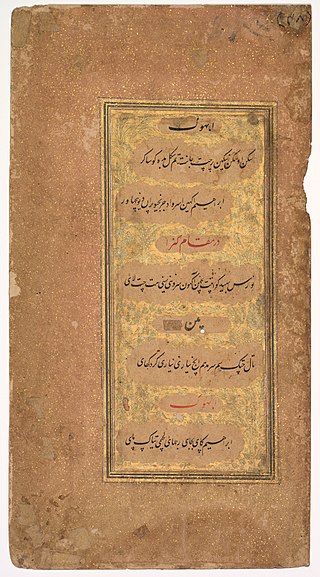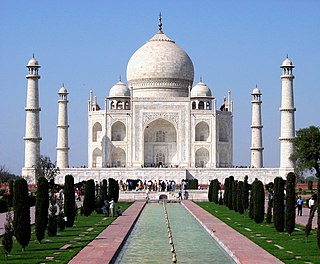
Modern Standard Hindi, commonly referred to as Hindi, is an Indo-Aryan language from the Indo-European language family. It is the standardised variety of the Hindustani language written in Devanagari script, the official language of India alongside English, and the lingua franca of North India. Hindi is considered a Sanskritised register of the Hindustani language, which itself is based primarily on the Khariboli dialect of Delhi and neighbouring areas. It is an official language in nine states and three union territories and an additional official language in three other states. Hindi is also one of the 22 scheduled languages of the Republic of India.

Urdu is an Indo-Aryan language spoken chiefly in South Asia. It is the national language and lingua franca of Pakistan, where it is also an official language alongside English. In India, Urdu is an Eighth Schedule language, the status and cultural heritage of which are recognised by the Constitution of India; and it also has an official status in several Indian states. In Nepal, Urdu is a registered regional dialect and in South Africa it is a protected language in the constitution. It is also spoken as a minority language in Afghanistan and Bangladesh, with no official status.

Hindustani is an Indo-Aryan language spoken in North India, Pakistan and the Deccan and used as the official language of India and Pakistan. Hindustani is a pluricentric language with two standard registers, known as Hindi and Urdu. Thus, it is also called Hindi–Urdu. Colloquial registers of the language fall on a spectrum between these standards. In modern times, a third variety of Hindustani with significant English influences has also appeared which is sometimes called Hinglish or Urdish.

Deccani is an Indo-Aryan language spoken in the Deccan region of south-central India and the native language of the Deccani people. The historical form of Deccani sparked the development of Urdu literature during the late-Mughal period. Deccani arose as a lingua franca under the Delhi and Bahmani Sultanates, as trade and migration from the north introduced Hindavi to southern India. It later developed a literary tradition under the patronage of the Deccan Sultanates. Deccani itself came to influence Hindustani, on which Urdu and Hindi are based.

Abu'l Hasan Yamīn ud-Dīn Khusrau, better known as Amīr Khusrau, was an Indo-Persian Sufi singer, musician, poet and scholar who lived during the period of the Delhi Sultanate.
Indian literature refers to the literature produced on the Indian subcontinent until 1947 and in the Republic of India thereafter. The Eighth Schedule to the Constitution of India has 22 officially recognised languages. Sahitya Akademi, India's highest literary body, also has 24 recognised literary languages.

A Persianate society is a society that is based on or strongly influenced by the Persian language, culture, literature, art and/or identity.

Urdu literature comprises the literary works, written in the Urdu language. While, It tends to be dominated by poetry, especially the verse forms of the ghazal and nazm, it has expanded into other styles of writing, including that of the short story, or afsana. Urdu literature is popular mostly in Pakistan, where Urdu is the national language, and in India, where it is an Eighth Schedule language.

The Qutb Shahi dynasty was a Persianate Shia Islamic dynasty of Turkoman origin that ruled the Sultanate of Golkonda in southern India. After the collapse of the Bahmani Sultanate, the Qutb Shahi dynasty was established in 1512 AD by Sultan-Quli Qutb-ul-Mulk, better known in English, though less correctly referred to, as "Quli Qutb Shah".

Indo-Persian culture refers to a cultural synthesis present on the Indian subcontinent. It is characterised by the absorption or integration of Persian aspects into the various cultures of modern-day republics of Bangladesh, India, and Pakistan. The earliest introduction of Persian influence and culture to the subcontinent was by various Muslim Turko-Persian rulers, such as the 11th-century Sultan Mahmud Ghaznavi, rapidly pushed for the heavy Persianization of conquered territories in northwestern Indian subcontinent, where Islamic influence was also firmly established. This socio-cultural synthesis arose steadily through the Delhi Sultanate from the 13th to 16th centuries, and the Mughal Empire from then onwards until the 19th century. Various Indo-Muslim dynasties of Turkic, local Indian and Afghan origin patronized the Persian language and contributed to the development of a Persian culture in India. The Delhi Sultanate developed their own cultural and political identity which built upon Persian and Indic languages, literature and arts, which formed the basis of an Indo-Muslim civilization.
Hindustani is one of the predominant languages of South Asia, with federal status in the republics of India and Pakistan in its standardized forms of Hindi and Urdu respectively. It is widely spoken and understood as a second language in Nepal, Bangladesh, and the Persian Gulf and as such is considered a lingua franca in the northern Indian subcontinent. It is also one of the most widely spoken languages in the world by total number of speakers. It developed in north India, principally during the Mughal Empire, when the Persian language exerted a strong influence on the Western Hindi languages of central India; this contact between the Hindu and Muslim cultures resulted in the core Indo-Aryan vocabulary of the Indian dialect of Hindi spoken in Delhi, whose earliest form is known as Old Hindi, being enriched with Persian loanwords. Rekhta, or "mixed" speech, which came to be known as Hindustani, Hindi, Hindavi, and Urdu, also locally known as Lashkari or Lashkari Zaban in long form, was thus created. This form was elevated to the status of a literary language, and after the partition of colonial India and independence this collection of dialects became the basis for modern standard Hindi and Urdu. Although these official languages are distinct registers with regards to their formal aspects, such as modern technical vocabulary, they continue to be all but indistinguishable in their vernacular form. From the colonial era onwards, Hindustani has also taken in many words from English, with an urban English-influenced variety emerging known as Hinglish.
The Persian language and Urdu have had an intricate relationship throughout the history of the latter. Persian historically played a significant role in the formation and development of the modern Urdu, and today acts as its prestige language.

Apabhraṃśa is a term used by vaiyākaraṇāḥ since Patañjali to refer to languages spoken in North India before the rise of the modern languages. In Indology, it is used as an umbrella term for the dialects forming the transition between the late Middle and the early Modern Indo-Aryan languages, spanning the period between the 6th and 13th centuries CE. However, these dialects are conventionally included in the Middle Indo-Aryan period. Apabhraṃśa in Sanskrit literally means "corrupt" or "non-grammatical language", that which deviates from the norm of Sanskrit grammar.

The Hindi–Urdu controversy arose in 19th century colonial India out of the debate over whether Modern Standard Hindi or Standard Urdu should be chosen as a national language.

Rekhta was an early form of the Hindustani language. This style evolved in both the Perso-Arabic and Devanagari scripts and is considered an early form of Modern Standard Urdu and Modern Standard Hindi. According to the Pakistani linguist and historian Tariq Rehman, Rekhta was a highly Persianized register of Hindustani, exclusively used by poets. It was not only the vocabulary that was Persianized, but also the poetic metaphors, inspired by Indian landscapes and seasons, were abandoned in favor of the Persian ones i.e. bahaar (spring) replacing barsaat.
The composite Turko-Persian, Turco-Persian, or Turco-Iranian is the distinctive culture that arose in the 9th and 10th centuries AD in Khorasan and Transoxiana. According to the modern historian Robert L. Canfield, the Turco-Persian tradition was Persianate in that it was centered on a lettered tradition of Iranian origin; it was Turkic in so far as it was for many generations patronized by rulers of Turkic ancestry; and it was "Islamicate" in that Islamic notions of virtue, permance, and excellence infused discourse about public issues as well as the religious affairs of the Muslims, who were the presiding elite."
Old Hindi, or Khariboli was the earliest stage of the Hindustani language, and so the ancestor of today's Hindi and Urdu. It developed from Shauraseni Prakrit and was spoken by the peoples of the region around Delhi, in roughly the 10th–13th centuries before the Delhi Sultanate.

Sufism has a history in India evolving for over 1,000 years. The presence of Sufism has been a leading entity increasing the reaches of Islam throughout South Asia. Following the entrance of Islam in the early 8th century, Sufi mystic traditions became more visible during the 10th and 11th centuries of the Delhi Sultanate and after it to the rest of India. A conglomeration of four chronologically separate dynasties, the early Delhi Sultanate consisted of rulers from Turkic and Afghan lands. This Persian influence flooded South Asia with Islam, Sufi thought, syncretic values, literature, education, and entertainment that has created an enduring impact on the presence of Islam in India today. Sufi preachers, merchants and missionaries also settled in coastal Gujarat through maritime voyages and trade.

Before British colonisation, the Persian language was the lingua franca of the Indian subcontinent and a widely used official language in North India. The language was brought into South Asia by various Turkics and Afghans and was preserved and patronized by Local Indian dynasties from the 11th century onwards, notable of which were the Ghaznavids, Sayyid Dynasty, Tughlaq dynasty, Khilji dynasty, Mughal Dynasty, Gujarat Sultanate, Bengal sultanate etc. Initially it was used by Muslim dynasties of India but later started being used by Non-Muslim empires too, For example the Sikh empire, Persian held official status in the court and the administration within these empires. It largely replaced Sanskrit as the language of politics, literature, education, and social status in the subcontinent.
Hindustani, also known as Hindi-Urdu, like all Indo-Aryan languages, has a core base of Sanskrit-derived vocabulary, which it gained through Prakrit. As such the standardized registers of the Hindustani language (Hindi-Urdu) share a common vocabulary, especially on the colloquial level. However, in formal speech, Hindi tends to draw on Sanskrit, while Urdu turns to Persian and sometimes Arabic. This difference lies in the history of Hindustani, in which the lingua franca started to gain more Persian words in urban areas, under the Delhi Sultanate; this dialect came to be termed Urdu.














